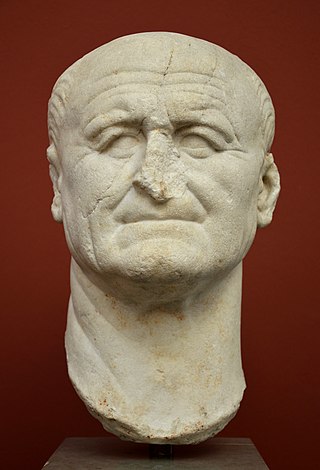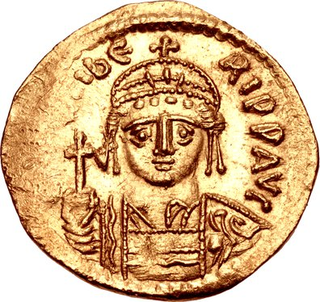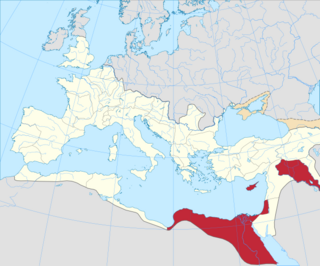The Julian calendar is a solar calendar of 365 days in every year with an additional leap day every fourth year. The Julian calendar is still used as a religious calendar in parts of the Eastern Orthodox Church and in parts of Oriental Orthodoxy as well as by the Amazigh people.

Anastasius I Dicorus was Eastern Roman emperor from 491 to 518. A career civil servant, he came to the throne at the age of 61 after being chosen by Ariadne, the wife of his predecessor, Zeno. His reign was characterized by reforms and improvements in the empire's government, finances, economy and bureaucracy. The resulting stable government, reinvigorated monetary economy and sizeable budget surplus allowed the empire to pursue more ambitious policies under his successors, most notably Justinian I. Since many of Anastasius' reforms proved long-lasting, his influence over the empire endured for centuries.

Vespasian was Roman emperor from 69 to 79. The last emperor to reign in the Year of the Four Emperors, he founded the Flavian dynasty, which ruled the Empire for 27 years. His fiscal reforms and consolidation of the empire brought political stability and a vast building program.

Maurice was Byzantine emperor from 582 to 602 and the last member of the Justinian dynasty. A successful general, Maurice was chosen as heir and son-in-law by his predecessor Tiberius II.

Lucius Cassius Dio, also known as Dio Cassius, was a Roman historian and senator of maternal Greek origin. He published 80 volumes of the history of ancient Rome, beginning with the arrival of Aeneas in Italy. The volumes documented the subsequent founding of Rome, the formation of the Republic, and the creation of the Empire up until 229 AD, during the reign of Severus Alexander. Written in Ancient Greek over 22 years, Dio's work covers approximately 1,000 years of history.
A calendar era is the period of time elapsed since one epoch of a calendar and, if it exists, before the next one. For example, the current year is numbered 2025 in the Gregorian calendar, which numbers its years in the Western Christian era.
Gaius Avidius Cassius was a Syrian Roman general and usurper. He was born in Cyrrhus, and was the son of Gaius Avidius Heliodorus, who served as praefectus or governor of Roman Egypt, and Julia Cassia Alexandra, who was related to a number of royal figures, including her descent from both Augustus and Herod the Great. He began his military career under Antoninus Pius, rising to the status of legatus legionis. He served during the Parthian war of Lucius Verus, in which he distinguished himself, for which he was elevated to the Senate, and later made Imperial legate. During the Bucolic War, he was given the extraordinary title of Rector Orientis, giving him Imperium over all of the eastern provinces of the Roman Empire.

The Antonine Plague of AD 165 to 180, also known as the Plague of Galen, was a prolonged and destructive epidemic, which impacted the Roman Empire. It was possibly contracted and spread by soldiers who were returning from campaign in the Near East. Scholars generally believed the plague was smallpox, due to the skin eruptions over the entirety of the body which appeared to be red and black (Horgan), although measles has also been suggested, and recent genetic evidence strongly suggests that the most severe form of smallpox arose in Europe much later. As yet, there is no genetic evidence from the Antonine plague.

Anno Mundi, abbreviated as AM or A.M., or Year After Creation, is a calendar era based on the biblical accounts of the creation of the world and subsequent history. Two such calendar eras of notable use are:
Chronicon Paschale, also called Chronicum Alexandrinum, Constantinopolitanum or Fasti Siculi, is the conventional name of a 7th-century Greek Christian chronicle of the world. Its name comes from its system of chronology based on the Christian paschal cycle; its Greek author named it Epitome of the ages from Adam the first man to the 17th year of the reign of the most August Heraclius.

The Byzantine calendar, also called the Roman calendar, the Creation Era of Constantinople or the Era of the World, was the calendar used by the Eastern Orthodox Church from c. 691 to 1728 in the Ecumenical Patriarchate. It was also the official calendar of the Byzantine Empire from 988 to 1453 and it was used in Russia until 1700. This calendar was used also in other areas of the Byzantine commonwealth such as in Serbia — where it is found in old Serbian legal documents such as Dušan's Code, thus being referred as the "Serbian Calendar" and today still used in the Republic of Georgia alongside Old Style and New Style calendar.

In the early Roman Empire, from 30 BC to AD 212, a peregrinus was a free provincial subject of the Empire who was not a Roman citizen. Peregrini constituted the vast majority of the Empire's inhabitants in the 1st and 2nd centuries AD. In AD 212, all free inhabitants of the Empire were granted citizenship by the Constitutio Antoniniana, with the exception of the dediticii, people who had become subject to Rome through surrender in war, and freed slaves.
Publius Licinius Nerva was a Roman politician during the Late Roman Republic. As a propraetor he was assigned as Governor of Sicily in 104 BC at the outbreak of the Second Servile War.
Centesima rerum venalium was a 1% tax on goods sold at auction during the Roman Empire.
The Bostran era was a calendar era with an epoch corresponding to 22 March 106 AD. It was the official era of the Roman province of Arabia Petraea, introduced to replace dating by regnal years after the Roman annexation of the Nabataean Kingdom. It is named after the city of Bostra, which became the headquarters of the Sixth Legion stationed in the province.

The ancient city of Constantinople was divided into 14 administrative regions. The system of fourteen regiones was modelled on the fourteen regiones of Rome, a system introduced by the first Roman emperor Augustus in the 1st century AD.
Gaius Minicius Italus was a Roman eques who flourished during the reign of the emperors Vespasian, Domitian, and Trajan. He was appointed to a series of imperial offices, both military and civil, culminating with praefectus or governor of Roman Egypt.
Marcus Mettius Rufus was a Roman eques who flourished during the reign of the emperors Domitian and Trajan. He was appointed to a series of imperial offices, including praefectus or governor of Roman Egypt.
In Ancient Rome, there were four primary kinds of taxation: a cattle tax, a land tax, customs, and a tax on the profits of any profession. These taxes were typically collected by local aristocrats. The Roman state would set a fixed amount of money each region needed to provide in taxes, and the local officials would decide who paid the taxes and how much they paid. Once collected the taxes would be used to fund the military, create public works, establish trade networks, stimulate the economy, and to fund the cursus publicum.

The term "Diaspora Revolt", also known as the Trajanic Revolt and sometimes as the SecondJewish–RomanWar, refers to a series of uprisings that occurred in Jewish diaspora communities across the eastern provinces of the Roman Empire during the final years of Trajan's reign. These revolts occurred while the emperor was engaged in his Parthian campaign in Mesopotamia, which provided a favorable opportunity. The ancient sources do not specify the exact motivations, but they were likely influenced by the destruction of the Second Temple by the Romans in 70 CE, long-standing tensions between Jews and Greeks, the Fiscus Judaicus tax, messianic expectations, and hopes for a return to Judaea.








